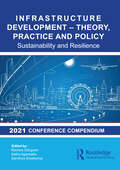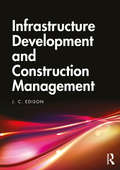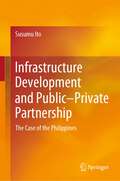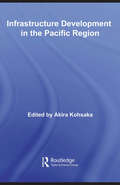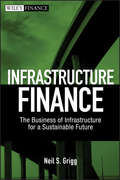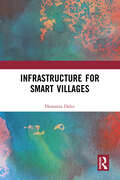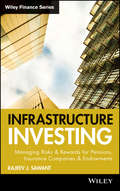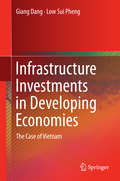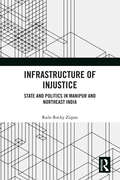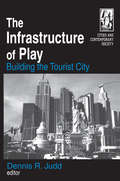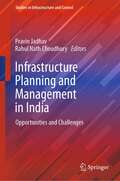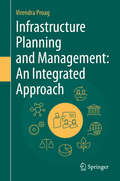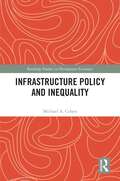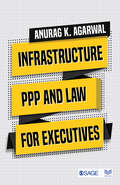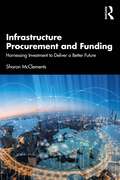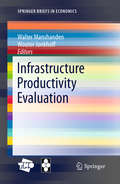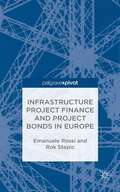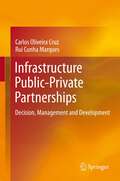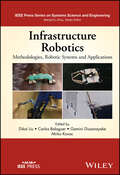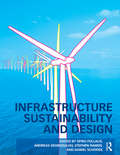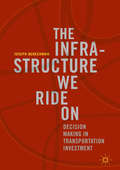- Table View
- List View
Infrastructure Development – Theory, Practice and Policy: Sustainability and Resilience
by Rachna Gangwar Astha Agarwalla Sandhya SreekumarThis compendium presents the papers presented in the conference 'Infrastructure Development Theory, Practice, and Policy' held on 29th and 30th April, 2021. It brings together the select papers from the conference and other contributions from experts and researchers. The compendium puts together the research under various themes, and we hope that the theoretical findings will impact the practice and policy in the future, as well as pave the way for future research in the direction of achieving more efficient, and more humane infrastructure.
Infrastructure Development and Construction Management
by J. C. EdisonThis is a comprehensive book on infrastructure development and construction management. It is written keeping in mind the curricula of construction management programmes in India and abroad. It covers infrastructure development, the construction industry in India, financial analysis of the real estate industry in India, economic analysis of projects, tendering and bidding, contracts and contract management, FIDIC conditions of contract, construction disputes and claims, arbitration, conciliation and dispute resolution, international construction project exports and identifying, analysing and managing construction project risk. Thus, this book covers most of the construction management activities that are carried out at different stages of a construction project. This is an essential book for students of construction management, construction professionals, academicians and researchers.
Infrastructure Development and Public–Private Partnership: The Case of the Philippines
by Susumu ItoThis is the first book that analyzes public–private partnership (PPP) infrastructure development in developing countries by focusing on recent developments in the Philippines.Infrastructure is extremely important for economic development and poverty reduction. However, given the infrastructure gap and pressures on public expenditure, there is a growing expectation that PPP will fill this gap globally. Over the years, PPP as a mechanism for financing and procuring infrastructure has been the basis of an active and provocative debate in the Philippines, which is known to have inadequate infrastructure—twice in the 2010s, when a significant policy shift on the financing source of public infrastructure was announced by the Philippine government. Drastic policy changes concerning the roles of public finance and PPP in infrastructure development within this decade are not seen in other developing countries.There is no precedent for substantial study on the changes of infrastructure governance in the Philippines, but this book assesses policy changes in infrastructure development in the country and, as academic contributions, identifies several factors behind the changes related to infrastructure governance there, especially the drastic shifts during the Aquino III and Duterte administrations. Furthermore, the findings presented in the book, including the desirable role of public finance and PPP in developing infrastructure in developing countries, could improve infrastructure governance, such as choice of the financing mode, design, and implementation of the PPP project, in other developing countries as an operable contribution to policymakers of government and to industry and management practitioners.
Infrastructure Development in Nigeria: A Political and Economic History (African Governance)
by Michael O. OnolememenThis book examines the politics and economics of infrastructure development in Nigeria from Independence in 1960 up to 2015, and the role of good governance in promoting the socioeconomic wellbeing of citizens. Arguing for the need for transformational leadership in infrastructure development, the chapters examine policy issues and survey the various administrative, economic, and social-political reforms that have impacted infrastructure development in Nigeria. The author also discusses current national development plans and Vision 20:2020; challenges to infrastructure development, including corruption; and the future potential of a strong infrastructure network for the economy and citizens. Drawing upon his experience within government departments, as well as existing models of leadership and governance, the author explores the role of infrastructure development in promoting the wellbeing and growth of Nigeria. Combining theory with practical examples of good governance, this book will be of interest for students and researchers of political science and infrastructure development in Africa.
Infrastructure Development in the Pacific Region (Routledge Studies in International Business and the World Economy)
by Akira KohsakaIn the past, undersupply of public infrastructure was blamed for low productivity growth in the United States in the 1970s, while greater private sector participation was emphasized for infrastructure development in the Asia-Pacific region before the Asian Economic Crisis in the 1990s. This revealing book looks at the current economic situation and the state of infrastructure on both sides of the Pacific. Including contributions from leading authorities such as Satya Paul, Jim Storey, Tony Makin and Naoyuki Yoshino, this book closely investigates the experiences of Japan, Canada, the US, China, Korea and Australia.
Infrastructure Finance
by Grigg Neil S.A comprehensive look at the emergence of infrastructure finance Just as infrastructure development acts as a catalyst for economic growth, it is also changing the landscape for potential investors and the burgeoning field of infrastructure finance. Infrastructure systems for transportation, utilities, and public works are essential for economic growth and have quickly developed into an emerging alternative asset class. Infrastructure Finance examines how the activities associated with updating and creating efficient transportation and communications, reliable and affordable energy, clean water, and other essential systems, have become a profitable financial endeavor. Recently, providing, operating, and maintaining infrastructure has advanced as a recognized and important investment sector that reaches beyond earlier business models. Infrastructure Finance puts this field in perspective and details what you need to know to succeed within it. An informative look at infrastructure finance-an emerging alternative investment for all types of institutional investors Dissects the central organizational and financial issues behind the revolutions that are occurring in infrastructure management and finance Contains detailed guidance for navigating the dynamic field of infrastructure finance Discusses infrastructure as arteries of life for a better world Highlights infrastructure undergoing transformations to adapt to turbulent environments Focuses on Green infrastructure to balance economic and environmental changes As infrastructure finance continues to grow in importance, you'll need to enhance your understanding of its essential aspects. Infrastructure Finance will provide you with the insights to achieve this goal.
Infrastructure for Smart Villages
by Hemanta DoloiThis book intends to initiate a fresh articulation of need-based infrastructure provisions in rural contexts. Departing from the conventional theories and practices of infrastructure planning and development applied in urban settings, the book presents a comprehensive suite of technical and non-technical indicators that rationalise fit-for-purpose planning, development, and operations of rural infrastructure. Drawing from global practices in public and private sectors and research-based evidence, a distinctive argument is put forward for promoting location-specific infrastructure development from effectiveness, practicality, affordability, and sustainability perspectives. The argument encompasses wider social, cultural, and economic contexts that are unique to rural settings and the book highlights a clear roadmap of how the UN’s sustainable development goals (SDGs) are at the core of developing rural communities with necessary infrastructure provisions that are purpose-built, affordable, risk averse, and resilient.This book will provide an overview of some of the little-understood and sometimes counter-intuitive best practices on rural infrastructure and value-based priorities that have emerged in uplifting rural communities in developing economies over the last 30 years. Drawing from the global literature and practice-based evidence across a complete spectrum of relevant disciplines, this book will provide readers with a clear articulation of the innovative ideas around harnessing rural potential, and empowering rural communities with added support in growth and progressive development in the context of interconnected infrastructure systems and improved living standards. It is key reading for development, planning, and infrastructure courses as well as professionals and researchers involved in international development, aid, and provision in rural areas.
Infrastructure in Nigeria: Unlocking Pension Fund Investments
by John D. Macomber Pippa Tubman ArmerdingCase
Infrastructure Investing: Managing Risks & Rewards for Pensions, Insurance Companies & Endowments (Wiley Finance #549)
by Rajeev J. SawantInvaluable information regarding one of the biggest worldwide growth areas in investing-infrastructure assets Infrastructure investing is about to explode on the worldwide scene. The fact is that real money will need to be spent on real projects-which will present real opportunities for stable, long-term returns. But infrastructure assets have unique characteristics and the investments and funds that will likely rise up must be suitably structured to serve investor needs. Author Rajeev Sawant has been analyzing infrastructure investments, funds, and project financing programs for nearly five years, and with this book, he presents information that will be invaluable to lenders, pension funds, insurance companies, investment funds, rating agencies, and even governments. Presents comprehensive data analysis on infrastructure cases worldwide Analyzes the opportunities as well as the pitfalls of infrastructure investing Focuses on the needs of pensions, insurance companies, and endowments interested in infrastructure investing For the next decade, worldwide economic growth and increased employment-as well as investment returns-will come from infrastructure projects. This book will help you understand today's dynamic infrastructure asset class and quickly get you up to speed on the unique risks and rewards associated with it.
Infrastructure Investments in Developing Economies
by Giang Dang Low Sui PhengThis book aims to provide knowledge on how infrastructure is planned and built in a typical developing country, and what key variables are there in the system limiting the efficient use of public investments in infrastructure. The book begins with a comprehensive literature review on construction and economic development, and trade and economic development. The focus of the book is on the case of Vietnam, with lessons drawn for other developing economies. The book employs the mixed use of data to provide a stronger basis for analysis and interpretation of related government policies. Based on the research findings, the book recommends significant capacity building work for Vietnam to develop capacities that would remove constraints on the efficient use of public investments in infrastructure. The general principles of significant capacity building work which are useful for policy implications are introduced in the book. Analysts, academics, public and private communities in developing countries can adopt the research findings as guiding principles to bring about changes in their current use of public investments in infrastructure, thus supporting their trade and economic growth in the long term.
Infrastructure of Injustice: State and Politics in Manipur and Northeast India
by Raile Rocky ZiipaoThis book examines the dynamics of infrastructure development in Northeast India especially Manipur from a socio-anthropological perspective. It looks at the pattern and distribution of infrastructure in the region to analyse the impact of education, roads and healthcare on the livelihoods, ecosystems, governance, and social futures of communities. The volume examines the infrastructure deficit in the conflict-ridden state of Manipur, focusing especially on electricity and roads. The author shows how problems arising from poor infrastructure are further complicated on account of corruption, insurgency, ethnic unrest and the politics of marginalization. Looking at the discourse around development in the Northeast, the volume also highlights the structural inequality in Manipur and other states. It further shows how infrastructure development can become a means for enabling trade, creating markets, diluting boundaries between varied ethnic groups and connecting people. This book will be useful for researchers and scholars of development studies, economics, social anthropology, sociology and public policy; particularly those interested in India’s Northeast.
The Infrastructure of Play: Building the Tourist City
by Dennis R. JuddUsing in-depth case studies, this volume shows how the infrastructure of tourism has transformed cities throughout North America. It makes clear that the modern urban environment is being thoroughly altered to emphasize the growing tourism sector in such areas as renovated waterfronts.
Infrastructure Planning and Management in India: Opportunities and Challenges (Studies in Infrastructure and Control)
by Rahul Nath Choudhury Pravin JadhavThis book addresses comprehensive issues of infrastructure management at the sectoral level in India. This book analyses four critical sectors viz. Transportation, Power, Urban, and Digital Infrastructure and their planning and management from an Indian perspective. The book also identifies empirical risks and challenges in the planning and management of infrastructure in India. A diverse set of management solutions that can support better infrastructure management across sectors are also discussed in the present book.
Infrastructure Planning and Management: An Integrated Approach
by Virendra ProagThis book explains how water, electricity/power, roads and other infrastructure services are linked together within the general basket of development and how to obtain the optimum use of resources. The emphasis, nowadays, is on multipurpose activities, optimum use of resources, environmental approach, minimum use of energy. This book tries to integrate all of these, by showing the links between the different components of infrastructure and trying to model them. A well articulated, socially attractive and desirable project may fail during the implementation or operation stage, not only from bad design, but also due to inadequate attention paid to the human aspects required for its operation. This book is intended for graduates and practising professionals who are involved in the general development planning of their country/region. It enables better understanding, collaboration and communication with other professionals in relation to their own or different disciplines.
Infrastructure Policy and Inequality (Routledge Studies in Development Economics)
by Michael A. CohenThis book reframes the purpose of infrastructure from being an input to economic growth to becoming a major instrument in reducing socio-economic inequalities in both industrialized and developing countries.Drawing on global and national lessons of COVID-19 and extensive working experience in 55 countries, this book reviews infrastructure policies and performance over several decades and suggests that the “underperformance” of infrastructure could be improved by more attention to users and the demand side, and thereby contribute to overcoming many obstacles facing low-income communities around the world. This book argues that growth is not a necessary condition for sustainability or social justice, and that both are undermined by structural inequalities which reduce the income and opportunities of urban households. More focus on user needs can substantially change the distribution of benefits and the quality of living conditions of low-income people. It provides a unique theoretical and on-the-ground critique of conventional infrastructure practices while illustrating to readers the many positive experiences around the world. More infrastructure is not enough; different and better is needed. This book reviews World Bank experience in launching a 30-year program to alleviate urban poverty through some 7,000 projects, showing that many significant policy changes have led to a big improvement in global urban policies adopted by national and local governments, yet have failed to significantly address and reduce intra-urban inequalities.The audience for this book includes academics, both faculty and advanced graduate students, while also a wider public interested in the prospects for international development.
Infrastructure, PPP and Law for Executives
by Anurag K. AgarwalPPP (public–private partnership) is a buzzword, especially in growing economies like India where it takes a partnership between the government and a private entity to establish successful infrastructural projects. However, PPPs in India face many hurdles that lead to either long delays or surprisingly, sometimes early completion of PPP projects, but with quality getting compromised. This book will take readers inside the world of PPPs and show how the legal, regulatory and political environments have facilitated or obstructed the speedy enforcement of plans for the creation of requisite infrastructure in India. With the help of various case studies, the book discusses the legal and regulatory issues in different sectors of infrastructure in India such as power, telecom, rail, air, road and sea. In addition to discussing challenges faced by them, the book emphasizes that a proper legal framework with effective regulations is necessary to monitor and regulate the creation and management of public goods. From funding to legal issues, Infrastructure, PPP and Law for Executives shows what it takes for the safe sailing for PPPs in India. Written primarily from a managerial perspective, the book will be of interest to business managers, lawyers, government executives and anyone with serious interest in infrastructure development in India.
Infrastructure Procurement and Funding: Harnessing Investment to Deliver a Better Future
by Sharon McClementsInfrastructure is vital to a resilient society and infrastructure investment is therefore critical to the vibrant functioning of societies. Infrastructure assets span economic and social spheres, but despite the prime importance of infrastructure investment, national governments simply cannot fund all of society's infrastructure requirements. This book, Infrastructure Procurement and Funding explores the key models of procuring and financing major projects and infrastructure works whilst critically acknowledging the inherent challenges in successfully securing the necessary funding. The book provides the reader with a detailed review of contemporary methods of financing and procuring infrastructure projects, commencing with an examination of the role of infrastructure in society in creating resilient societies. It reviews public sector funding mechanisms for infrastructure investment and then introduces, before presenting emerging trends in private sector investment in infrastructure. Fundamentally this book identifies robust, innovative, and contemporary solutions to the procurement, financing and investment in major infrastructure projects, globally, nationally and regionally. The book is ideal reading for international courses in construction procurement, construction project management, infrastructure asset management, real estate investment and finance, but will also be useful for those construction business leaders in public and private sectors who are responsible for making major project and infrastructure financial and investment decisions.
Infrastructure Productivity Evaluation
by Walter Manshanden Wouter JonkhoffInfrastructure construction and use is at the heart o the current political debate. Not only are European member state governments investing large amounts of money to alleviate the harmful effects of the economic downturn due to the credit crisis, EU accession countries receive large amounts of cohesion funds for infrastructure purposes. Infrastructure is widely believed to contribute largely to economic performance, but to what extent is this the case? How does the productivity of roads, railways and ports relate to the invested money, and what determines their effectiveness? In this Brief, which focuses to a large extent on Dutch and European practice, numerous distinguished economists describe policy practice and analytical tools for infrastructure appraisal. Moreover, harmonisation of European approaches for evaluation of infrastructure are discussed. The study focuses both on scientific productivity measurement as on case studies of infrastructure policy.
Infrastructure Project Finance and Project Bonds in Europe
by Emanuele Rossi Rok StepicThis book analyses the project bond financing solution in detail, identifying all the specific features that make it highly suitable for large capital intensive infrastructure projects.
Infrastructure Provision and the Negotiating Process (Urban and Regional Planning and Development Series)
by Frank EnnisThe provision of infrastructure for urban developments is increasingly becoming a highly contentious and important issue in planning negotiations. By drawing together a range of case studies from North America, Australia and Europe, this book compares how a number of planning systems deal with this issue. There is a general trend by planning agencies towards the securing of infrastructure from the private sector. This necessitates a negotiation process between planning agencies, developers and infrastructure providers and this volume shows how this process varies according to the political context, the nature of the planning system and the existence of other frameworks such as Environmental Impact Assessment. By doing so, the collection presents an original perspective on both the negotiation process in planning and on how infrastructure should be provided.
Infrastructure Public-Private Partnerships: Decision, Management and Development
by Carlos Oliveira Cruz Rui Cunha MarquesEconomic development and social welfare depend on the existence of effective and efficient infrastructure systems, particularly in health, energy, transportation and water, many of which are developed and managed through Public-Private Partnerships (PPPs). However, empirical evidence suggests some pitfalls in the use of these PPP arrangements. This book addresses these issues, focusing on mostly three key questions: How to improve the robustness of the decision-making process leading to the option of PPP? How to improve contract management as the longest phase of the process? How can contracts be improved to accommodate uncertainty and avoid harmful renegotiations? The authors explore the concept of flexible contracts, the uncertainty modeling for improving the robustness of the decision-making process, and develop an overall framework for effective contract management, along with a comprehensive analysis of current renegotiation patterns. The ultimate goal is to improve the contractual performance, as well as the overall infrastructure management and social welfare.
Infrastructure Robotics: Methodologies, Robotic Systems and Applications (IEEE Press Series on Systems Science and Engineering)
by Dikai Liu Carlos Balaguer Gamini Dissanayake Mirko KovacInfrastructure Robotics Illuminating resource presenting commonly used robotic methodologies and technologies, with recent developments and clear application examples across different project types Infrastructure Robotics presents state-of-the-art research in infrastructure robotics and key methodologies that enable the development of intelligent robots for operation in civil infrastructure environments, describing sensing, perception, localization, map building, environmental and operation awareness, motion and task planning, design methodologies, robot assistance paradigms, and physical human-robot collaboration. The text also presents many case studies of robotic systems developed for real-world applications in maintaining various civil infrastructures, including steel bridges, tunnels, underground water mains, underwater structures, and sewer pipes. In addition, later chapters discuss lessons learned in deployment of intelligent robots in practical applications overall. Infrastructure Robotics provides a timely and thorough treatment of the subject pertaining to recent developments, such as computer vision and machine learning techniques that have been used in inspection and condition assessment of critical civil infrastructures, including bridges, tunnels, and more. Written by highly qualified contributors with significant experience in both academia and industry, Infrastructure Robotics covers topics such as: Design methods for application of robots in civil infrastructure inspired by biological systems including ants, inchworms, and humans Fundamental aspects of research on intelligent robotic co-workers for human-robot collaborative operations The ROBO-SPECT European project and a robotized alternative to manual tunnel structural inspection and assessment Wider context for the use of additive manufacturing techniques on construction sites Infrastructure Robotics is an essential resource for researchers, engineers, and graduate students in related fields. Professionals in civil engineering, asset management, and project management who wish to be on the cutting edge of the future of their industries will also benefit from the text.
Infrastructure Sustainability and Design
by Spiro Pollalis Andreas Georgoulias Stephen Ramos Daniel SchodekYou're overseeing a large-scale project, but you're not an engineering or construction specialist, and so you need an overview of the related sustainability concerns and processes. To introduce you to the main issues, experts from the fields of engineering, planning, public health, environmental design, architecture, and landscape architecture review current sustainable large-scale projects, the roles team members hold, and design approaches, including alternative development and financing structures. They also discuss the challenges and opportunities of sustainability within infrastructural systems, such as those for energy, water, and waste, so that you know what's possible. And best of all, they present here for the first time the Zofnass Environmental Evaluation Methodology guidelines, which will help you and your team improve infrastructure design, engineering, and construction.
The Infrastructure We Ride On: Decision Making In Transportation Investment
by Joseph BerechmanThis book explores the various economic and institutional factors that explain why huge investments are made in unworthy transportation mega-projects in the US and other countries. It is based on research, the general literature, economic analyses, and results from a specifically collected database showing that a significant proportion of implemented mega-projects have been found to be inferior ex-ante or incapable of delivering the returns they promised ex-post. Transportation infrastructure and other public investments of a similar scope (“mega-projects”) reflect public sector priorities and objectives, non-pecuniary as well as financial constraints, and a range of decision-making processes. This book describes how decisions made in the public sector with respect to transportation infrastructure investments are affected by the large populations and territories they serve, the estimation of the substantial opportunity costs they entail, the formal procedures instituted for quantitatively appraising projected outcomes and monetary returns, and the political environment in which these decisions are made.
Infrastructuring
by A. Coskun SamliThe recent global financial crisis has intensified concerns over how nations--both developed and developing -- can revitalize economic growth and ensure opportunity for prosperity to all citizens. Many analysts and policymakers alike are looking to new business creation and the promotion of entrepreneurial practices as a panacea, or at least as a partial solution. A. Coskun Samli has argued in his two most recent books that the current model of globalization tends to marginalize the poor and that developing countries must rely on local business development, rather than exogenous forces, such as aid, loans, and trade, to catalyze growth. This third book in his trilogy argues that a "bottom-up" approach is necessary for developing countries to participate in globalization--but is not sufficient. He proposes that the economic goals of a country, a region, or a company are fulfilled first and foremost by a properly designed and maintained infrastructure, encompassing both physical elements, such as transportation and communication systems, and qualitative elements, such as functioning educational, legal, and governing institutions. In Infrastructuring, Samli analyzes the experiences of a variety of countries, including China, India, Ireland, and South Africa, to highlight the role that infrastructure plays in economic development, and considers its implications for such timely issues as new business creation, productivity, and supply chain logistics. Moreover, he outlines practical approaches to infrastructure management and policy oversight.
